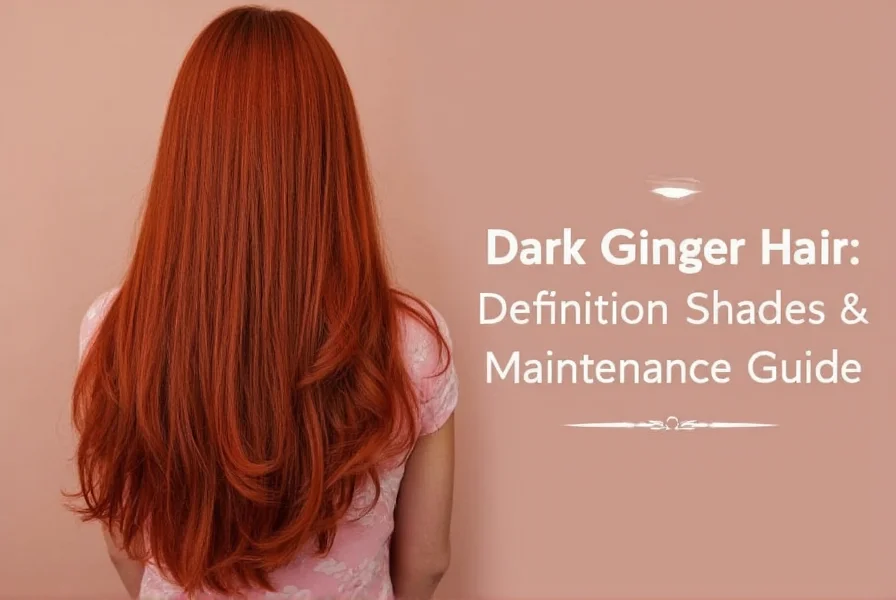Dark ginger hair has emerged as one of the most sought-after red hair variations in recent years, offering a sophisticated alternative to brighter ginger shades. Unlike the vibrant orange-red tones of classic ginger hair, dark ginger incorporates deeper, more muted copper and auburn notes that create a dimensional, natural-looking color. This shade typically ranges from medium to dark brown with pronounced red undertones, making it particularly flattering for those seeking red hair that doesn't appear artificially bright or high-maintenance.
Understanding Dark Ginger Hair Color
Dark ginger represents a specific spectrum within the red hair family, characterized by its depth and complexity. Professional colorists describe it as sitting between traditional ginger and auburn on the color spectrum, with more brown base tones than standard ginger but significantly more red than typical auburn shades.
| Red Hair Variation | Base Tone | Red Intensity | Best For Skin Tones |
|---|---|---|---|
| Dark Ginger | Medium to dark brown | Moderate to high | Medium, olive, cool fair |
| Traditional Ginger | Light to medium | Very high | Cool fair, porcelain |
| Auburn | Medium to dark brown | Low to moderate | Warm, neutral, medium |
Who Suits Dark Ginger Hair Best
One of dark ginger's greatest advantages is its versatility across skin tones. While traditional bright ginger often works best with cool, fair complexions, dark ginger's deeper base makes it suitable for a broader range. Individuals with medium skin tones, olive complexions, and even some warmer undertones can successfully wear dark ginger without the color appearing unnatural.
For those considering dark ginger hair color, pay attention to your natural undertones. Cool undertones (with pink or blue veins) typically pair beautifully with darker ginger shades that have violet or blue-red undertones. Warm undertones (with greenish veins) often look best with dark ginger variations that lean toward copper or golden-red tones.

Maintenance Requirements for Dark Ginger Hair
Contrary to popular belief, dark ginger hair often requires less maintenance than brighter red shades. The deeper base color means roots are less noticeable as they grow out, and the color tends to fade more gradually than vibrant reds. However, proper care remains essential for maintaining the richness of dark ginger tones.
Use color-safe, sulfate-free shampoos specifically formulated for red hair to prevent premature fading. Incorporate a purple or blue-toned shampoo once weekly to neutralize any brassy undertones that may develop. Regular conditioning treatments help maintain the hair's health, which is crucial since red pigments can be more drying to hair strands.
Professional colorists recommend touch-ups every 8-10 weeks for optimal dark ginger hair maintenance, compared to the 6-8 week interval often needed for brighter red shades. This extended timeframe makes dark ginger a more practical choice for those seeking red hair with manageable upkeep.
Dark Ginger Hair Color Application Process
Whether you're transitioning from natural hair color or converting from another shade, the application process for dark ginger requires careful consideration. For natural brunettes, the process typically involves minimal lightening, preserving hair integrity while adding the desired red tones.
Those with lighter bases may need subtle lightening to ensure the red pigment takes evenly, but dark ginger's depth means less aggressive lightening than would be required for brighter ginger shades. The application usually involves a combination of permanent color and gloss treatments to achieve the multidimensional effect characteristic of high-quality dark ginger coloring.

Common Misconceptions About Dark Ginger Hair
Many people assume all red hair requires excessive maintenance, but dark ginger actually offers a more sustainable option within the red spectrum. Its deeper base provides natural-looking regrowth, making it less demanding than brighter red shades.
Another misconception is that dark ginger only suits certain complexions. In reality, modern coloring techniques allow for customized dark ginger formulations that complement various skin tones. The key is finding the right balance of red and brown undertones to harmonize with individual features.
Long-Term Considerations for Dark Ginger Hair
As seasons change, you may notice your dark ginger hair appears differently under various lighting conditions. During summer months, the color may develop subtle golden highlights, while winter lighting often enhances the deeper red tones.
Over time, with proper care, dark ginger can evolve gracefully into a rich auburn as it fades, providing a natural transition rather than an abrupt color change. This characteristic makes it an excellent choice for those who prefer gradual color evolution rather than frequent dramatic changes.
Does dark ginger hair suit fair skin tones?
Yes, dark ginger works exceptionally well with fair skin tones, particularly those with cool or neutral undertones. The deeper base prevents the high contrast that sometimes makes brighter ginger shades overwhelming on very fair complexions, creating a more balanced, natural appearance.
How often should I refresh my dark ginger hair color?
Most colorists recommend professional touch-ups every 8-10 weeks for dark ginger hair. The deeper base color means roots are less noticeable than with brighter reds, allowing for slightly longer intervals between appointments compared to traditional ginger shades.
Can I achieve dark ginger hair at home?
While possible, achieving professional-looking dark ginger at home can be challenging. The shade requires precise balance of red and brown tones, and improper application may result in brassy or uneven color. For best results, consult a professional colorist experienced with red hair variations, especially for your initial application.
Does dark ginger hair fade to orange?
Dark ginger typically fades to a rich auburn rather than orange when properly maintained. Using color-safe products formulated for red hair and incorporating occasional color-depositing conditioners can help maintain the desired copper-brown balance as the color gradually fades.











 浙公网安备
33010002000092号
浙公网安备
33010002000092号 浙B2-20120091-4
浙B2-20120091-4